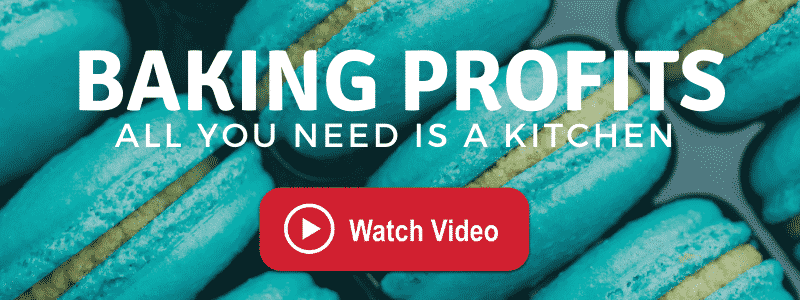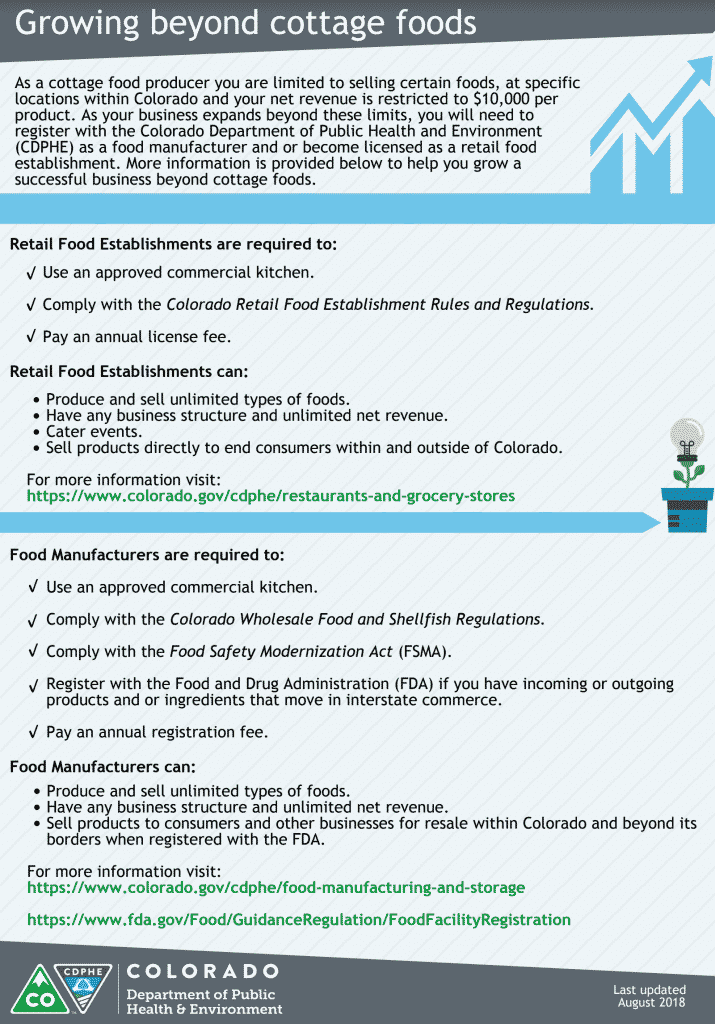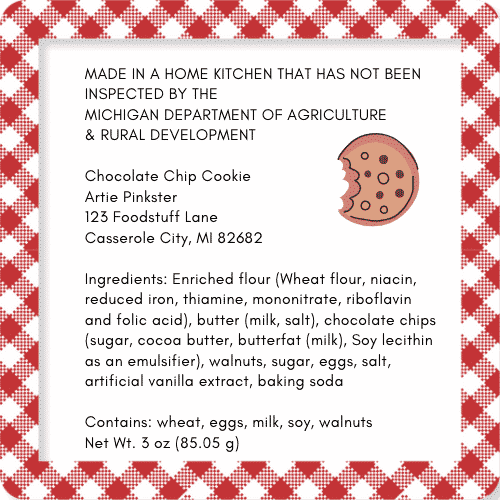Michigan cottage food laws make it easy to open but encourages your business to expand into a full fledged retail business by putting a cap on your income you’re allowed to make annually.
However, getting started is as simple as saying… I’m going to open and run my own cottage food operation from my home.
Michigan Cottage Food Laws, PA 113 of 2010 exempts a “cottage food operation” from the licensing and inspection provisions of the Michigan Food Law.
NOTE: Although against the intent and purposes of the limitations, many cottage food vendors find it near impossible to grow beyond cottage food being limited to $25,000 annually, so some don’t report accurately while saving until their income reaches something more reasonable – in able to open a licensed commercial kitchen with no limitations. 😉
Table of Contents
HOW TO START YOUR COTTAGE FOOD BUSINESS IN MICHIGAN – LICENSING

To start your cottage food business, simply follow the steps below.
If you have any questions please contact MDARD – Michigan Department of Agriculture and Rural Development here: 800-292-3939
HOME FOOD OPERATIONS REQUIREMENTS
- Start Right Now – No License or Permit needed (see steps to start in next section)
- Food safety training certificate is not required (see food safety section on this page)
- Michigan caps your allowable income annually to $25,000.00
- Food sold face to face, online, markets, stands and in some cases online but delivered in person
- Food limited to non TCS (Temperature Control for Safety) only – this is standard across the country as all cottage food operations are limited to non-potentially hazardous / TCS foods.
- Food labeling required
STEPS TO START
Always contact your local city / county office and verify if a business license is required prior to starting.
This is simply done by calling the main number to your city and letting them know you are starting a cottage food business and ask if you need a business license.
Link to Michigan list of county contacts.
- Pick foods to offer from the “allowed” food types listed below.
- Check with your local city/county for any zoning restrictions
- Get labels made (see label example below)
- Start baking/cooking, marketing and selling
MICHIGAN COTTAGE FOOD LAWS – Foods That Are Allowed
The following are examples of products allowed to be made from your home. Keep in mind that some items are not allowed.
Always check first: (see contact info below) VERIFY ANY FOOD YOU PLAN TO MAKE… CALL: 800-292-3939
BREAD
- Bagels
- Biscuits
- Breads
- Brownies
- Cakes
- Cookies
- Doughnuts
- Muffins
- Pizzelles
- Rolls
- Scones
- Sweet breads
- Tortillas
Candy
- Baked candy
- Brittles
- Chocolate
- Cotton candy
- Fudge
Condiments
- Honey
- Ketchup
- Mustard
- Nut butters
- Oils
- Sauces
- Vinegars
Dry goods
- Cereals
- Coffee beans
- Dried fruit
- Dried vegetables
- Herbs
- Mixes
- Pasta noodles
- Spices & Seasonings
- Tea leaves
Pastries
- Cones
- Empanadas
- Other Pastries
- Pies
Snacks
- Caramel corn
- Chocolate-covered items
- Crackers & Pretzels
- Fruit leathers
- Granola
- Kettle corn
- Marshmallows
- Nuts & seeds
- Popcorn
- Popcorn balls
Preserves
- Fruit jams & jellies in glass jars that can be stored at room temperature (except vegetable and other non-fruit based jams/jellies)
- Marmalades
If your food item is in question and not listed above, you can reach out and see if your food would be considered non-TCS / non-potentially hazardous:
Michigan Department of Agriculture and Rural Development – MDARD
[email protected]
800-292-3939
Real Life Cottage Food Entrepreneurs and Opportunities
- Cakes – teacher turns kitchen into bakery
- Doughnuts – cottage mini donut vendor
- Fruit jams and jellies – See Additional Requirements Here
- Kettle corn – real kettle corn vendors from home
- Popcorn (plain and flavored) – see a real home vendor here
- Talk and Join hundreds of others here: VendorsUnited.com
MICHIGAN COTTAGE FOOD LAWS – PROHIBITED FOODS
- Pickles
- Sauces
- Foods that require refrigeration / perishable foods
- Fermented foods, including kombucha
- Drinks
- Any potentially hazardous foods found on this list
MICHIGAN ANNUAL SALES LIMITS
Most states set a cap on what you’re allowed to make annually.
This is usually put in place to push you towards opening a full-fledged retail business while at the same time letting you start from home.
Michigan has an annual sales limit for cottage food entrepreneurs at $25,000. Below is what the state of Colorado puts out to help folks wanting to go beyond cottage foods.
Michigan, like Colorado shown as an example below have taken steps to help you expand beyond cottage food.
Here is a page where you can learn about growing beyond Cottage Food in Michigan.
Colorado created a brochure on going beyond cottage food once you’ve outgrown or hit your maximum allowed income.
I have provided it here for a resource as you grow your business and wish to expand.

ACIDITY LEVELS AND TESTING
Most states determine if a food is non-potentially hazardous by the acidity level found in the food. The higher the acidity, the more stable at a range of temps, that food product is.
For example: milk is low acidity and requires temperature controls.
The acidity of foods is measured by pH.
• The range of pH is commonly considered to extend from zero to 14.
A pH value of 7 is neutral because pure water has a pH value of exactly 7. Values less than 7 are considered acidic, while those greater than 7 are considered basic or alkaline.
• All fruits are acidic foods and are usually tart and sour. Ex: tomato, lemon, peach, apple, etc.
• The FDA rule for acidic foods states that a food must have a pH below 4.6 to be sold as a minimally processed food.
• The reason for this is bacteria does not grow at this level of acidity.
• The exclusion shall not be construed as allowing the sale of low acid foods (pH > 4.6) in
hermetically sealed containers (i.e. home-canned green beans, peas, etc.) when such
food is not prepared in a permitted establishment.
TESTING
Some states require testing if the pH level is unknown. For many food products, the pH level is already known.
You can test for pH yourself using a pH spear tester. (make sure it is made for food and has a long spear tip).
Oklahoma State University shares an awesome guide for selecting the correct tester for foods and liquids which includes tips and tricks for operation and maintenance. Get The Guide Here.
MICHIGAN COTTAGE FOOD LAWS LABELING REQUIREMENTS
The basic information that must be on the label is as follows:
- Name and physical address of the Cottage Food operation. (You must use the physical address of your home kitchen; Post Office Box addresses are not adequate).
- Name of the Cottage Food product (All capital letters or upper/lower case are both acceptable).
- The ingredients of the Cottage Food product, in descending order of predominance by weight.
If you use a prepared item in your recipe, you must list the sub ingredients as well. For example: soy sauce is not acceptable, soy sauce (wheat, soybeans, salt) would be acceptable, please see the label below for further examples. - The net weight or net volume of the Cottage Food product (must also include the metric equivalent – conversion charts are available online).
- Allergen labeling as specified in federal labeling requirements.
- The following statement: “Made in a home kitchen that has not been inspected by the Michigan Department of Agriculture & Rural Development” in at least the equivalent of 11-point font (about 1/8″ tall) and in a color that provides a clear contrast to the background (All capital letters or upper/lower case are both acceptable).
Hand-printed labels are acceptable if they are clearly legible, written with durable, permanent ink, and printed large enough to equal the font size requirements listed above.
Here is an example of a label that should help you develop your own labels:
- The name and address of the Cottage Food Operation;
- The name of the Cottage Food Product;
- The ingredients of the Cottage Food Product, in descending order of predominance by weight;
- The net weight or net volume of the Cottage Food Product;
- Allergen information as specified by federal labeling requirements.
This includes identifying if any of the ingredients are made from one of the following food groups: sesame seeds, milk, eggs, wheat, peanuts, soybeans, fish (including shellfish, crab, lobster or shrimp) and tree nuts (such as almonds, pecans or walnuts); AND - Nutritional labeling as specified by federal labeling requirements is required if any nutrient content claim, health claim, or other nutritional information is provided.
MICHIGAN COTTAGE FOOD LABEL EXAMPLE

Below is an example of Michigan requires on their labels.
Using VistaPrint.com or similar – you can quickly create professional labels that not only serve to meet the state cottage food guidelines but also serve for marketing your awesome business and products.
You’ll find some fantastic examples of this from members inside VendorsUnited.com
ALLERGENS ON LABELING
The FDA lists nine (9) major food allergens. Listing any of these on your label is a smart business practice and will certainly help your customers choose a product.
- Milk
- Eggs
- Fish (e.g., bass, flounder, cod)
- Crustacean shellfish (e.g., crab, lobster, shrimp)
- Tree nuts (e.g., almonds, walnuts, pecans)
- Peanuts
- Wheat
- Soybeans
- Sesame seeds
Simply add to your label: “NOTICE: SOYBEANS USED IN THIS RECIPE” Some go as far to announce that a certain allergen is used in the same kitchen.
Some states require you list any potential allergens and potential for any cross contamination even if the allergen is not used in the recipe.
FDA Allergen Labeling Example: Contains Wheat, Milk, Egg, and Soy
WHERE CAN I SELL MY COTTAGE FOOD PRODUCTS
Michigan Cottage Food Laws – Sales Rules
Cottage food products can be sold directly to a consumer from a residence, at a farmer’s market, at a public event, by personal delivery and online.
However they do not allow mail order products.
All sales, including online sales, are restricted to:
Events
Farmers markets
Home
Online – Social Media is an excellent method. Discover how our VU members do this.
Roadside stands
Delivery
Pickup
Inside kitchenincome.com you can find out how many cottage food entrepreneurs are getting sales faster than they can make the food.
FOOD HANDLER TRAINING AND BEST PRACTICES
Michigan does NOT require you take a food safety course.
However, knowing the safe handling practices will protect you and your customers, it is always a good idea to take a quick online class and get certified.
There are many short courses you can take online and actually get certified and be able to share that with your customers.
Many of our VendorsUnited.com members are proud to display their food safety certificates as a way to insure their customers that they care. This helps your business.
- Short courses that provide food handling and safety certification
- Free info from the FDA – food safety
SAFE PRACTICES
Much of this may seem like common sense, but even if you already know, it’s a good idea to remind yourself with a list of things that can prevent you from missing something small.
And if for no other reason… CYA! CYA = Cover Your A#%
CLEAN WORK AREA / WORK SPACE / SANITIZATION
Providing safe to eat foods from your kitchen – starts in your kitchen.
Keep your area clean and sanitized to avoid cross contamination and to insure you provide your customers and clients with the safest and best foods they can get.
The following are some “common” sense things you can do to insure the best environment for preparing foods to sell:
- Keep all equipment and surface areas clean and sanitized
- Make sure window and door screens are bug proof with no gaps
- Keep ingredients separate to prevent cross contamination / e.g. raw eggs near flour
- No pets in work area and preferably none in the home
- Allow no-one with a cold, sniffles or sick in kitchen while preparing foods
- Wipe down walls and clean floors daily
- Use good lighting to avoid missing unclean areas
- Keep window and door screens in good repair to keep insects out
- Wash hands frequently while working and use food grade gloves for extra safety
- Keep areas of food storage and equipment storage clean and sanitized
RECORD KEEPING
Why keep these types of records?
Let’s say the inspector calls you and says they got a report that your banana bread, someone purchased, made them sick.
You’ll be able to show that you didn’t even make banana bread that week and that the person who reported you, bought that 4 weeks ago and you weren’t even the one that sold it to him.
This does not need to be complicated. I love my yellow legal pads and they make an inexpensive tool for keeping up with the following:
- The recipes you use including ingredients
- The process you use to prepare that specific recipe: (can be just like recipe instructions)
- Date made (can be coded for your own use only if your state doesn’t require the production date) e.g. Made 12.22.29 = 292212
- Date sold (you can have a batch code to help track a certain batch) Simply write down date you sold an item
- Location sold is another great piece of information to keep track of
- Sales receipts are something great to keep for a couple of reasons and over at KitchenIncome.com I dive into the best practices, best systems and best methods for tracking, managing, selling and shipping.
COTTAGE FOOD lIABILITY INSURANCE
We live in a society that likes to sue. I can sue you for wearing that color shirt. No kidding!
Of course I probably won’t win, but at the very least, it’s gonna cause you stress and some costs.
Liability insurance is a MUST.
It can be expensive – but several years ago, I found FLIP and by far, they gave me the most protection (coverage) and allow you to run your cottage food business without fear of being sued.
WHY? Because they provide the lawyers. And their lawyers… they are good!
Of course you should price shop around with your local agent or a national brand company, but rest assured, I’ve done all the legwork for you.
Alternatively, some folks opt to get bonded.
You’ve heard the saying before: “licensed and bonded”. A bond is usually provided from an insurance bonding company or your own insurance company.
My first time, I got a bond at State Farm.
A bond is expensive comparatively but is less out of pocket in the beginning. Of course, it’s way, way less insurance / coverage too.
A $10,000 bond may cost $50 annually while a $2,000,000.00 liability policy may cost a few hundred a year.
No matter what you decide… knowing you’re insured against frivolous lawsuits is worth every penny.
MICHIGAN COTTAGE FOOD LAWS IMPORTANT LINKS
- Michigan Cottage Food getting started checklist
- Michigan Cottage Food Laws Information including Frequently Asked Questions
- Michigan Cottage Food Mailing List – Stay Informed
- Michigan Expansion and Other Food Service Industry Links
- Become a Certified Mushroom Expert in Michigan
- Michigan Food Laws and Codes
- Zoning and County Map Contacts
- Instructions on Expanding to a full fledged commercial business – licensed processor
MICHIGAN COTTAGE FOOD CONTACT INFO
Michigan Department of Agriculture & Rural Development
P.O. Box 30017
Lansing, Michigan 48909
[email protected]
1-800-292-3939
UPDATES TO MICHIGAN COTTAGE FOOD LAWS
From time to time, links, info, rules and numbers change, are updated or made obsolete.
Although I spend time daily with hundreds of vendors (many of which are cottage food businesses) – I can miss an update.
If you find a broken link or outdated state information… please let me know and I’ll send you a special thank you for helping me maintain the best site on the internet for the cottage food industry.
My goal has always been to have a central place that is absolutely free for those starting out or existing entrepreneurs who use their homes and kitchens to make real incomes.
Please send to [email protected] / or post inside the private VendorsUnited.com group.
Need more resources? Check it out HERE (Helpful Resources)
Take a peek at the best vendors on the planet, the community that rocks the food vending world: Vendors United…

Disclaimer
This information is provided to help those interested in starting a cottage food business. It is not a document made by the state government. This information is not provided as law nor should be construed as law. Always use the contact information for each state to confirm compliance and any changes.
Did we help you? Help us to share this information…
 WATCH VIDEO!
WATCH VIDEO! WATCH VIDEO!
WATCH VIDEO!
Hello , I don’t see anything for making pure vanilla extract or do I need a License to sell in Michigan ( Chelsea ). Thanks for any help you can give me
Hi, please check all the available info for your specific State at https://cottagefoodlaws.com/michigan-cottage-food-laws/. Anything else, you will need to call your local Health Dept.. Also we cover this inside the Vendors United group at vendorsunited.com, where you can talk with 100’s of real vendors and get instant advice that works
I have a question can you rent a space at a craft store to sell your product the store is not getting any money from the food sales only renting a space for you to sell it. Is this allowed?